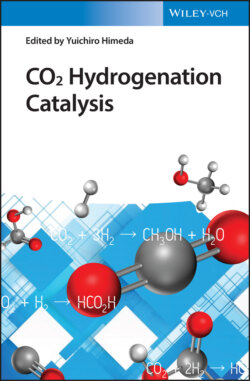Читать книгу CO2 Hydrogenation Catalysis - Группа авторов - Страница 19
1.4.1 CO 2 Supply
ОглавлениеCapture, purification, and transport of CO2 are essential for its utilization. Table 1.3 lists several large CO2 sources with their typical amounts and concentrations of CO2 as well as impurities. In present CO2 merchant market (approximately 230 Mton, US$7.7 billion), the fermentation process (i.e. bioethanol production) and ammonia production, which provide close to 100% CO2, are predominantly CO2 sources [5, 30]. The CO2 generated from ethanol fermentation commercially supplies roughly 270 000 ton of CO2 annually for EOR through pipeline from Kansas to Texas [28]. On the other hand, the production of electricity and heat accounts for 41% of global CO2 emissions (Figure 1.4), and the transport and industrial sectors account for an additional 25% and 19%, respectively [32]. However, suitable sources of CO2 for use in chemical transformation are limited. The gases contain various impurities, the separation of which is both energy and cost intensive. To supply CO2 of an appropriate quality for use in chemical conversion processes, capture and separation are required (Table 1.4) [33]. The most effective CO2 capture method as the current industrial standard is chemical absorption in an aqueous solution of an amine‐based organic compound. However, the cost (35 US$/ton) and energy consumption (2.5 GJ ton−1) of amine capture must still be reduced to provide economically viable routes from carbon dioxide to fuels [34, 35].
Table 1.3 Concentration of CO2 and contaminants from various sources.
Source: Carbon Recycling International; Capturing and Utilizing CO2 from Ethanol: Adding Economic Value and Jobs to Rural Economies and Communities While Reducing Emissions (2017); and Greenhouse Gas Inventory Data [9, 28, 29].
| Source | Amount/Mton | CO2 concentration/% | Impurities |
|---|---|---|---|
| Ethanol fermentation [28, 30] | 50 | 99 | EtOH, MeOH, H2O, H2S |
| Anhydrous ammonia | 30 | >95 | NH3, CO, H2, H2O |
| Natural deposits | 13 | 90–100 | N2, O2, He |
| Power plants | 4287 | 10–15 | N2, H2O, SOx, NOx, CO |
| Steelmaking | 266 | 18–20 | N2, SOx, NOx, O2 |
| Cement production [31] | 220 | 14–33 | SOx, NOx, O2 |
| Atmosphere | 3 200 000 | 0.04 | N2, O2, SOx, NOx |
Figure 1.4 CO2 emissions from fuel combustion.
Source: Data from IEA, CO2 emissions from fuel combustion, 2020 [32].
Table 1.4 CO2 capture technologies.
Source: Based on Styring [33].
| Capture technology | Technical principle |
|---|---|
| Chemical absorption | Chemical reaction between CO2 and absorbent by a temperature swing. |
| Physical absorption | Dissolution of CO2 into a liquid, the efficiency of which depends on the solubility of CO2 in the liquid. |
| Solid absorption | Absorption into solid absorbents, which include porous materials impregnated with amines for low‐temperature separation or other solid absorbents for high‐temperature separation. |
| Physical adsorption | Adsorption onto porous solids such as zeolites by a pressure or temperature swing. |
| Membrane separation | Permeation through a membrane with selective permeability for different gas species. |
Recently, the direct capture of CO2 from ambient air, called direct air capture (DAC), has received increasing attention [36]. One of the advantages of DAC is that it can be located anywhere, because it is unnecessary for CO2 transport. However, from both engineering and chemistry views, there remains much room for improvements to the sorbents and processes. Additionally, thorough techno‐economic analyses of DAC processes are necessary [37].
